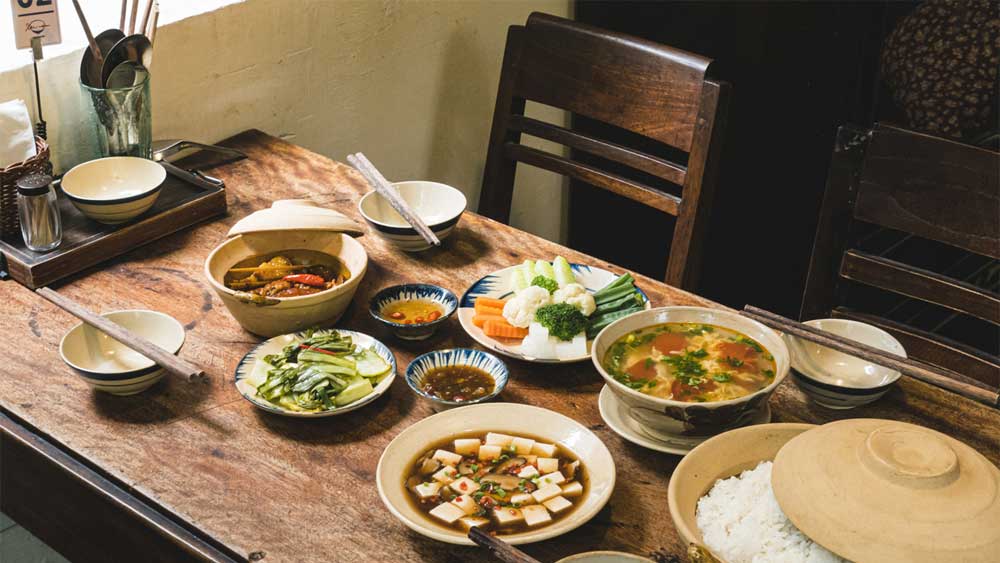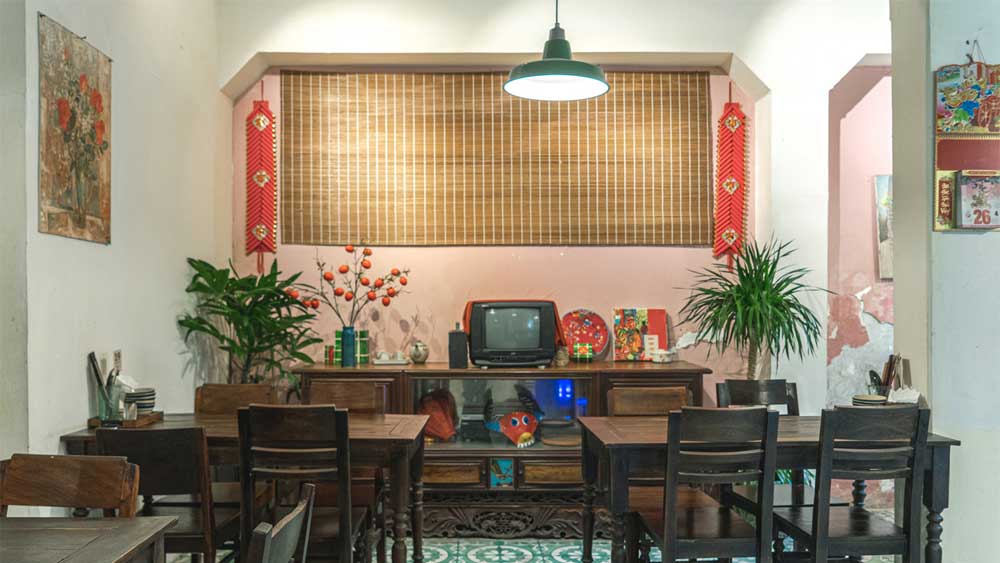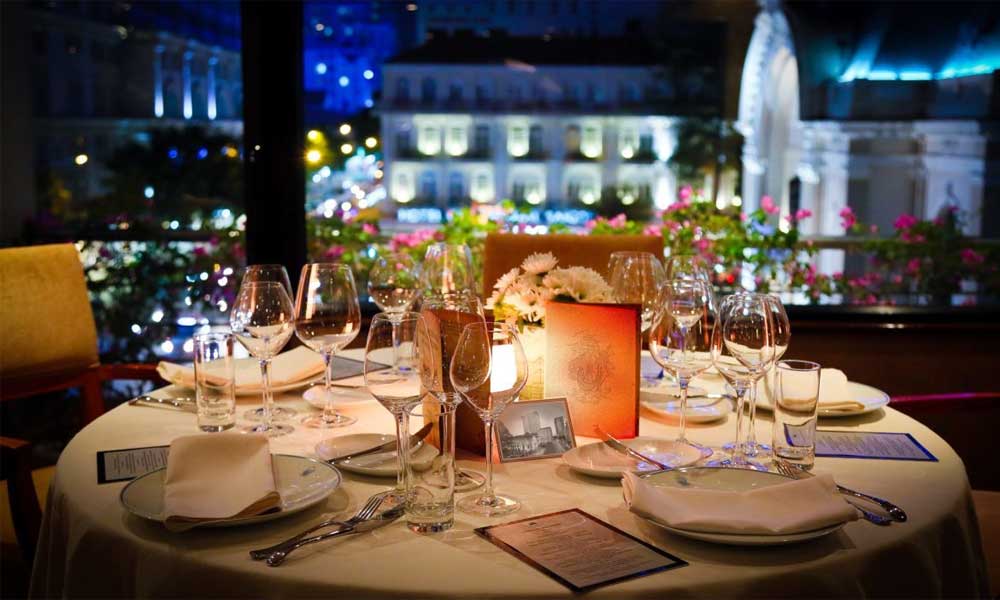Xoi Com: Michelin's northern Vietnam homestyle favorite
In June, Xoi Com ("Serving Rice") earned its place on the list of 29 Michelin Guide Bib Gourmand restaurants in Vietnam. Bib Gourmand selections are celebrated for their simple and easy-to-enjoy cooking style that offer delicious meals at budget-friendly prices.
 |
|
A meal for four people includes tofu, egg-tomato soup, steamed veggies, braised pork, and pickles. |
Around noon, Xoi Com's 14 tables are almost always full.
Located at house number 107, Lane 36, Lang Ha Street, Dong Da District, the lively ambiance of the restaurant stands in contrast to its nostalgic decor reminiscent of 1990s Hanoi.
Housed in a well-preserved, decades-old dormitory, Xoi Com maintains its authenticity. The rice bowls and plates are sourced from nearby craft villages, and the dessert plates are made from ash glaze, a hallmark of Vietnamese ceramics since the 11th century.
The connection to the past extends to the dua ca – extra-long flat wooden chopsticks of varying sizes at each end, reflecting traditional rice-stirring practices.
Le Minh Tung, the owner, opened Xoi Com in 2020 as a passion project (he’s a successful communications executive). In just three years, the restaurant has already earned recognition from Michelin in the "Bib Gourmand" category.
True to its name, Xoi Com's menu features uncomplicated yet satisfying dishes from the northern rice tradition, including stir-fried beef, fried shrimp, stir-fried chayote, and sweet and sour stir-fried ribs. The kitchen follows traditional methods, ensuring cleanliness and precision.
Ingredients such as meat, fish, and eggs are carefully sourced from reputable markets, while the vegetables come from small farmers in the mountainous northern regions of Mu Cang Chai and Son La. They are chosen based on the principle of seasonality, with a focus on local farm-to-table traditions.
For instance, when selecting pumpkins, Tung opts for older varieties, typically weighing around 6 kilograms each. Similarly, the ginger used has been stored for several years, ensuring fragrant essential oils without being overly spicy. Hyacinth beans must also be of the older varieties—plump, sweet, with a subtle light purple hue on the edges of the beans, characteristics not commonly found in the city.
A typical meal comprising a vegetable dish, two protein dishes, a pot of rice, and dessert, costs around VND150,000 ($6) per person. The portions are quite satisfying for their prices. For example, a plate of sweet and sour fried ribs, containing about 5 to 6 pieces, costs VND85,000.
Diners often note that the flavors don't always match the superiority of home-cooked meals.
Thanh Ha, who works in Dong Da District, said the food was well-seasoned, though she found the portion a bit small in comparison to the price. But she still acknowledged the quality of each dish, the service style, and the overall ambiance of the restaurant.
Hong Ngoc, a first-time visitor, praised the overall food quality, mentioning that most dishes are subtly seasoned. She ordered a meal consisting of 5 dishes and drinks that cost around VND320,000 ($13). Her personal favorites included the tender braised meat with eggs and the well-cooked, non-sour pickled eggplant.
Tung understands that the restaurant's prices might be a tad high for those with an average income. However, he emphasizes that just because Vietnamese rice is associated with home-cooked food doesn't necessarily mean it comes at a cheap price.
He said that foreign fast food meals, and even sidewalk grilled meat or hot pots, typically cost around VND200,000 per meal while featuring predominantly frozen ingredients. He believes that high-quality fresh Vietnamese dishes "can absolutely be priced similarly."
The restaurant changes its menu daily and avoids the reuse of leftovers. Seasonal dishes are introduced to align with weather preferences. Summer offerings lean towards sour dishes, while winter emphasizes spicy, hot, and fried selections.
On average, the restaurant presents about 15 dishes each day, crafted from 30 to 45 ingredients. Six dishes are rotated daily, while the remaining nine consist of seasonal or fixed items such as eggs, soup, and rice.
Approximately an hour before opening, the restaurant conducts a thorough check of all prepared items to uphold its standards. Despite being relatively new to the culinary scene, both Tung and the restaurant's manager have cultivated a refined palate over the years. This experience allows them to evaluate flavors, discern the strengths and weaknesses of each ingredient, and continually enhance their culinary offerings.
 |
|
The dining area gives visitors a sense of being in a Hanoi living room in the late 90s. |
Since earning Michelin recognition, Tung said he has had a surge in customers and has even had to turn away many who did not make reservations. The increased numbers of customers has made the restaurant livelier, albeit a bit noisier than before.
Reflecting on the Michelin effect, he acknowledged both its positive and challenging aspects. Despite the increased demand, he takes pride in the fact that the traditional Vietnamese home cooked meals are now globally recognized as delicious by international experts.
Currently, the eatery has 6-9 employees per shift. With its inclusion in the "Bib Gourmand" list, Xoi Com has seen an influx of customers, both local and foreign. The restaurant's staff has adapted by learning English to assist foreign patrons and share Vietnamese rice culture.
While offers for franchising and additional investment have come in, Tung remains committed to maintaining the restaurant's unique quality. He believes that while Xoi Com does not need to be extravagant, every guest should experience "a taste of a home-style meal."
Source: VnExpress
 Bắc giang
Bắc giang















Reader's comments (0)